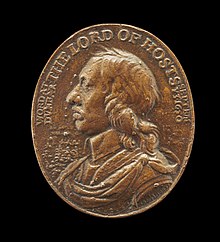Dunbar Medal (1650)
| Dunbar Medal | |
|---|---|
 The obverse of a silver Dunbar Medal | |
| Type | Campaign Medal |
| Awarded for | Campaign service |
| Presented by | Commonwealth of England |
| Eligibility | All officers and other ranks of the New Model Army who participated in the Battle of Dunbar on 3rd September 1650 |
| Campaign(s) | Battle of Dunbar (3 September 1650) |
| Clasps | None |
| Established | 1650 |
| First awarded | 1651 |
The Dunbar Medal is a campaign medal of the Commonwealth of England and was sanctioned by Parliament in 1650 to be awarded to officers and other ranks of the New Model Army who participated in the Battle of Dunbar on 3 September 1650.[1] Two versions were produced; one in gold for officers, and one in silver for other ranks.[1][2] The Dunbar Medal is thought by historians and numismatists to be the first ever military medal to be eligible to every man present in a campaign or engagement, irrespective of rank. It was worn by a cord or chain around the neck.[2] They were engraved by Thomas Simon, with an image of Oliver Cromwell on the obverse and a scene of the House of Commons on the reverse, the latter has also been found replaced in other media.[2][3]

References
[edit]- ^ a b "The Oldest English War Medal". American Journal of Numismatics, and Bulletin of the American Numismatic and Archaeological Society. 4 (8): 59–60. 1869. ISSN 2381-4586.
- ^ a b c Lessen, Marvin (1981). "THE CROMWELL DUNBAR MEDALS BY SIMON" (PDF). British Numismatic Journal. 51 (8): 112–133.
- ^ Beauchamp, Peter (2013). "Colouring the watch: Three outstanding examples of the enameller's art". The British Art Journal. 14 (2): 68–70. ISSN 1467-2006.
